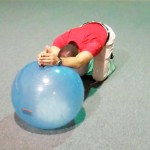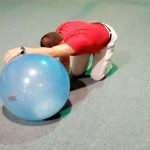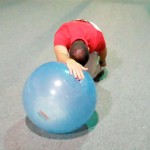Brian Schiff’s Blog
Injury Prevention, Sports Rehab & Performance Training Expert
This is the second installment of corrective “go-to” exercises I am highlighting here and in my online column for PFP magazine. Click here to read the post on resisted overhead squats. The in-line lunge allows for the observer to pick up flaws or asymmetry by placing the body in a narrow stance with a wide stride to assess hip, knee, ankle and foot mobility and stability of the client. It places the upper and lower extremities in alternate asymmetrical patterns.
Limited mobility or hip disassociation will produce movement dysfunction with the in-line lunge (see picture below for how it is assessed during the FMS).

A common corrective exercise prescribed to improve mobility is the leg lock bridge.
Execution: Begin in supine flexing one leg up to the chest. Hold the flexed leg against the chest while keeping the extended (down) leg in line with the center of the body and the knee flexed. A small ball (pictured below), pillow or towel roll may be placed between the thigh and chest for tactile feedback regarding the lock position.
Next, push down through the extended leg on the floor to elevate the hips off the ground into a bridge. The height of the bridge should be limited to the point where contact can be maintained between the thigh of the flexed hip and the chest keeping the extended hip/thigh in the in-line position. Perform 2-3 sets of 10-15 repetitions.

Application: The ability to stride in a lunge position without forward trunk lean during the in-line lunge can be inhibited by tight hip flexors. Soft tissue work and stretching is certainly helpful, but this active mobility exercise will improve reciprocal movement and facilitate hip disassociation. It is a great exercise to include as part of your corrective exercise series and/or movement and pillar prep work with your clients.
If clients struggle or experience hamstring cramping, consider adding a small step beneath the foot of the extended leg to increase the hip flexion starting position. Modifications and adjustments to sets, repetitions and distance between the flexed thigh and chest as well as the extended foot and ground should be considered with exercise prescription.
Soft tissue tightness and restriction in the latissimus dorsi is a common problem in overhead athletes, throwers, weight lifters and Crossfit participants. I often educate clientele on self myofascial release techniques using a trigger point ball or foam roller. But, I also like using a partner technique with the Stick.
Begin in standing grasping the frame of a squat rack. You may also elect to hold both handles of a TRX. Next, slowly squat down and lean back allowing the shoulders to move into flexion. Once in position, the trainer or workout partner will use the Stick to apply pressure and roll up and down along the latissimus especially working on the soft tissue near the shoulder.

Perform this technique for 30-60 seconds and then switch sides. Adjust pressure and location based on feedback from the client.
I work with several overhead athletes ranging from swimmers and tennis players to professional baseball pitchers. One consistent issue I see is tightness in the anterior chest wall coupled with poor scapular activation and stability. For that reason, I often turn to snow angel exercises. I wanted to share two variations I have written on before. The first version utilizes a foam roller. The movement is performed throughout a full arc of movement upward and downward.

Top position

Bottom position
Click here for more details on the execution of this exercise
This is an excellent exercise that can be integrated as part of a warm-up/movement prep session as well as used in recovery and the cool-down to address soft tissue tightness in the chest, facilitate proper posture and encourage scapular retraction and depression.
I often use this exercise in combination with pec minor myofascial release and thoracic spine extension mobilization on the roller. It is a staple in all of my rehab and prehab programs with all of my overhead athletes.
The second version involves moving to an upright position and can prove more challenging. The exercise is also designed to promote scapular stability. When done properly, the client will demonstrate proper upward rotation (avoid tipping and winging of the scapula) on the ascent, and then emphasize recruitment of the rhomboids and lower trap to achieve proper downward rotation on the descent.
It can be a very fatiguing activity and somewhat frustrating for clients when starting out. Be sure to cue them accordingly, and let them know it may not be easy to keep full contact. It may also be necessary to utilize soft tissue mobilization for the pecs/lats as well as stretching beforehand to promote a more normal movement pattern.

Top position

Mid position

Bottom position
In this anti-gravity version fatigue becomes more of an issue, so emphasizing quality movement and using less repetitions may be indicated. Do not push through any painful motion.
Click here for more details on the execution of this exercise
I always look for exercises that allow me to actively elongate traditionally short muscles while encouraging proper muscle activation of weak/poorly recruited muscles. This exercise does just that. If you are interested in the impact of pec minor tightness and shoulder impingement, check out the article from JOSPT below:
Many people struggle with faulty posture (forward head and rounded shoulders). Tightness in the pec major or pec minor can negatively affect the body. Often, the throwers I see suffer from tightness in this region. Any overhead athlete can be affected as well as the person who sits and types all day long in the office.
The video below reveals how to use a trigger point ball and block to work on soft tissue tightness. I like the TP ball and baller block from Trigger Point for this exercise sequence.
For more information on this technique and its application, click here to read my online column for PFP magazine. Note: the final “W” motion in the video is not described in the column article, but it is another option that can be included.
Working with athletes of many disciplines affords me an opportunity to look at many shoulders week to week. Increasingly, I am seeing more Crossfit athletes for various shoulder problems. In many cases, they have rotator cuff tendonitis, impingement, AC joint pain, labral pathology or a combination of the aforementioned issues. The other big group of athletes I see is throwers.
These two groups share many of the same dysfunctions including posterior shoulder tightness and decreased mobility. Tightness in the pecs and lats is commonplace. I feel latissimus tightness often goes unnoticed or perhaps is not an area of emphasis in prehab/rehab plans. Tight lats will restrict elevation and contribute to postural dysfunction.
With restricted elevation, athletes may turn to excessive spinal extension and/or rotation to achieve elevation necessary (e.g. overhead squats, snatches, throwing) and this can contribute to poor movement patterns. I have also seen this impact volleyball players asymmetrically with serving and hitting.
Lat tightness can easily be assessed by placing the athlete supine and simply asking them to bring the arms completely overhead. While most people do not have 180 degrees of flexion, I feel working to achieve elevation greater than or equal to 160 is completely reasonable. The body often uses abduction and external rotation to make things work (and this is natural for throwers), but the more pure elevation capacity we have the the better.
Crossfit involves lots of pull-ups and throwing heavily utilizes the pecs and lats for acceleration. It only follows that muscular tightness in this region may need to be addressed. Step one often involves soft tissue mobilization/compression techniques. I prefer to use a Trigger Point ball or Grid to work on the soft tissue mobilizing it on the wall (TP ball) or floor (Grid) in an elevated position.
Next, I like to employ active mobility work. I recently featured a simple exercise using the BOSU Ballast Ball in my PFP column. The pictures below reveal a rolling double arm version, as well as a single arm method/progression. These active movements can also be complimented by sustained holds as desired.
For a more detailed description and application of this exercise, click here to read my “Functionally Fit” column. I had one Crossfit enthusiast see me for limited shoulder mobility as it was hindering his overhead lifts and causing back pain. He had about 130 degrees of shoulder flexion. Daily STM using the foam roller, mobility work and some stretching increased his elevation by 10 degrees in 2-3 short weeks.
So, the take home message is that overhead athletes should assess and address this limitation if it is present as it may cause kinetic chain issues and energy leaks. Improving mobility will better enable utilization of proper muscle activation and optimal movement patterns.




